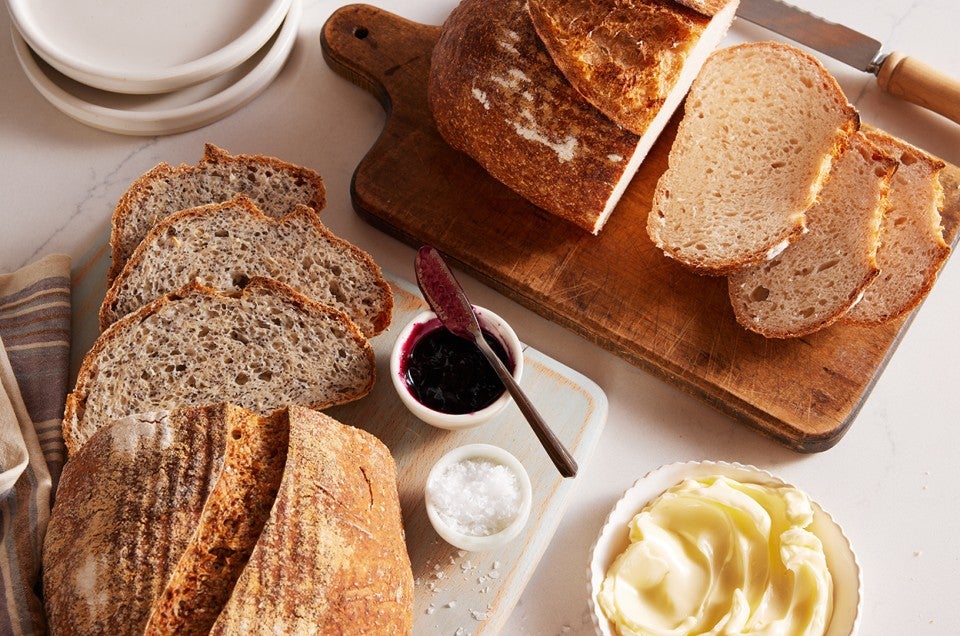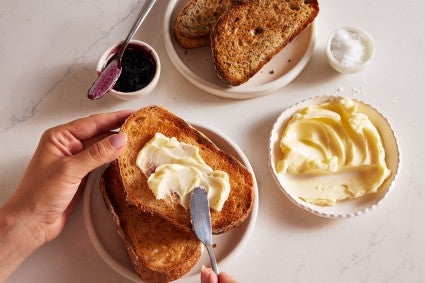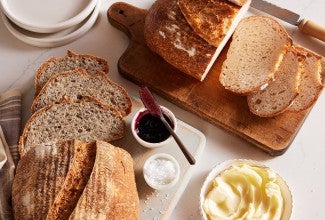How to make gluten-free sourdough bread
Everything you need to know to start making gluten-free sourdough.


We have good news: Great gluten-free sourdough bread is possible. It just takes the right tools, recipes, and of course, flour.
Whether you’re an experienced sourdough baker transitioning to being gluten-free or a committed gluten-free baker interested in starting your sourdough journey, we have everything you need to start baking. Start by making a gluten-free starter, then begin baking one of our gluten-free sourdough recipes. We’ve also got guidance on tools, ingredients, and gluten-free discard — let’s get baking.

Read: Which gluten-free flour should I use?
Read: Gluten-free bread: A guide to choosing your flour
You have several options. For the simplest solution, our primary recommendation is Gluten-Free Bread Flour, which, true to its name, is designed specifically for baking bread. In addition to including xanthan gum, which helps with binding, this flour also contains gluten-free wheat starch, which helps mimic the flavor of conventional flours and acts as a thickener. As a result, doughs are easier to work with and shape, and the baked bread has an excellent crumb and crust that mimics conventional loaves.
You can also make great gluten-free sourdough bread with our Gluten-Free All-Purpose Flour. This flour doesn’t include xanthan gum, which means you can control the amount of xanthan gum you add to the recipe — this is helpful, since gluten-free bread recipes typically need more xanthan gum than non-yeasted gluten-free recipes. This flour is also made from a blend of refined starches that prevent a gritty or gummy texture.

Recipe: Gluten-Free Sourdough Starter made with Bread Flour
Read: How to make gluten-free sourdough starter
To begin making gluten-free sourdough bread, you first need a gluten-free starter. We recommend this starter recipe, which uses Gluten-Free Bread Flour and closely mimics traditional starter in both process and performance.
(As an alternative, you can also make this gluten-free starter recipe, which uses Gluten-Free Measure for Measure Flour instead of Gluten-Free Bread Flour.)
Just like traditional starter, gluten-free sourdough starter will take several days and up to one week to get up and running. The good news is that the process for making gluten-free starter is quite similar to conventional starter: You mix flour and water, then let the mixture ferment over several days and up to one week, regularly feeding it with fresh flour and water to fuel the microorganisms powering fermentation.
If you’re not baking with your starter regularly, you’ll still need to keep feeding it regularly, the same way you would a traditional starter, to keep it active.
Like regular sourdough starter, gluten-free sourdough starter can be kept in the refrigerator between feedings. Be sure to feed it at least once a week for long-term storage to keep it healthy. If you keep your starter at room temperature, feed it once daily to maintain activity. (If you're storing your starter in the fridge, you'll want to take it out a few days before you bake with it and give it a couple of daily room temperature feeds until it's bubbling nicely and doubling in size.)

Gluten-Free Sourdough Bread: This recipe yields a classic, crusty artisan-style boule. The secret is Gluten-Free Bread Flour, which is used to make both the starter and the bread dough. For the most flavor and the best texture, let your dough chill overnight before baking; cool the baked bread in the oven (for a crispy crust); and resist the urge to slice into it until it has cooled for several hours (overnight is best).
Gluten-Free Sourdough Sandwich Bread: For a sturdy, sliceable sourdough sandwich loaf, turn to this recipe. It uses Gluten-Free All-Purpose Flour in the dough along with a starter made with Measure for Measure flour; additional ingredients like xanthan gum and eggs provide structure and help with binding to ensure a soft — not crumbly — texture.
Gluten-Free Sourdough Flatbread: If you're looking for a versatile gluten-free flatbread, try this recipe, made with Gluten-Free All-Purpose Flour; the flatbreads are great for dipping or folding around fillings to make a wrap. The recipe calls for both gluten-free starter and instant yeast to ensure a reliable rise, and like other recipes includes both xanthan gum and an egg for the best texture.

Dough Whisk: The unique shape of this whisk makes it great for stirring starter and bread dough, and it’s easy to clean, too.
Sourdough Crock: This glass crock takes the guesswork out of tending to your gluten-free starter. Its clear sides make it easy to see your starter’s activity, and the markings on the side allow you to measure how much it’s risen at a glance. The stainless-steel lid, meanwhile, keeps starter fresh but is still loose enough to let gases escape.
Bowl Scraper: There’s no better tool for easing sticky gluten-free bread dough out of the bowl; this scraper is also stiff enough to cleanly divide dough and scrape dried dough off your counter.
Lame: You can score bread dough with a sharp knife, but for the cleanest scoring (which translates to better bread) you need one of these thin, super-sharp blades.
Baking Stone: If you’re ready to take your gluten-free sourdough up a notch, invest in a baking stone. The heavy-duty stone absorbs the oven's heat, then transfers it to your bread dough, baking a perfectly crisp, golden crust and resulting in lots of oven spring for gorgeous height in your bread.
Digital Thermometer: Since gluten-free bread retains water longer than conventional bread, using a digital thermometer to measure internal temperature is the best indicator that it's fully baked.
Recipe: Gluten-Free English Muffin Bread (see tips at the bottom of the recipe page)
Gluten-free sourdough discard won’t automatically work in any recipe that calls for conventional sourdough discard; so if a recipe includes conventional discard, we don’t recommend using gluten-free discard in its place.
That said, you can experiment with using gluten-free discard to replace a portion of the gluten-free flour and water in gluten-free recipes, similar to how you can sub conventional starter into recipes. Pay attention to the ratio of flour to water when calculating your substitution: Gluten-Free Starter made with Bread Flour has a 2:1 ratio, by weight, of water to flour (unlike conventional starter, which has a 1:1 ratio). So if you’re subbing in this discard for the flour and water in a gluten-free recipe, 1 cup of discard (about 173g) will equal about 1/2 cup (113g) water and 1/2 cup (60g) Gluten-Free Bread Flour, approximately.
That said, if you prefer baking with your gluten-free sourdough discard using a recipe, we recommend our Gluten-Free English Muffin Bread. Follow the tips at the bottom of the recipe page for guidance on how to make this recipe with 1 cup of gluten-free sourdough discard.
Visit our Gluten-Free Shop for everything you need for gluten-free baking, from flours to mixes to tools.


